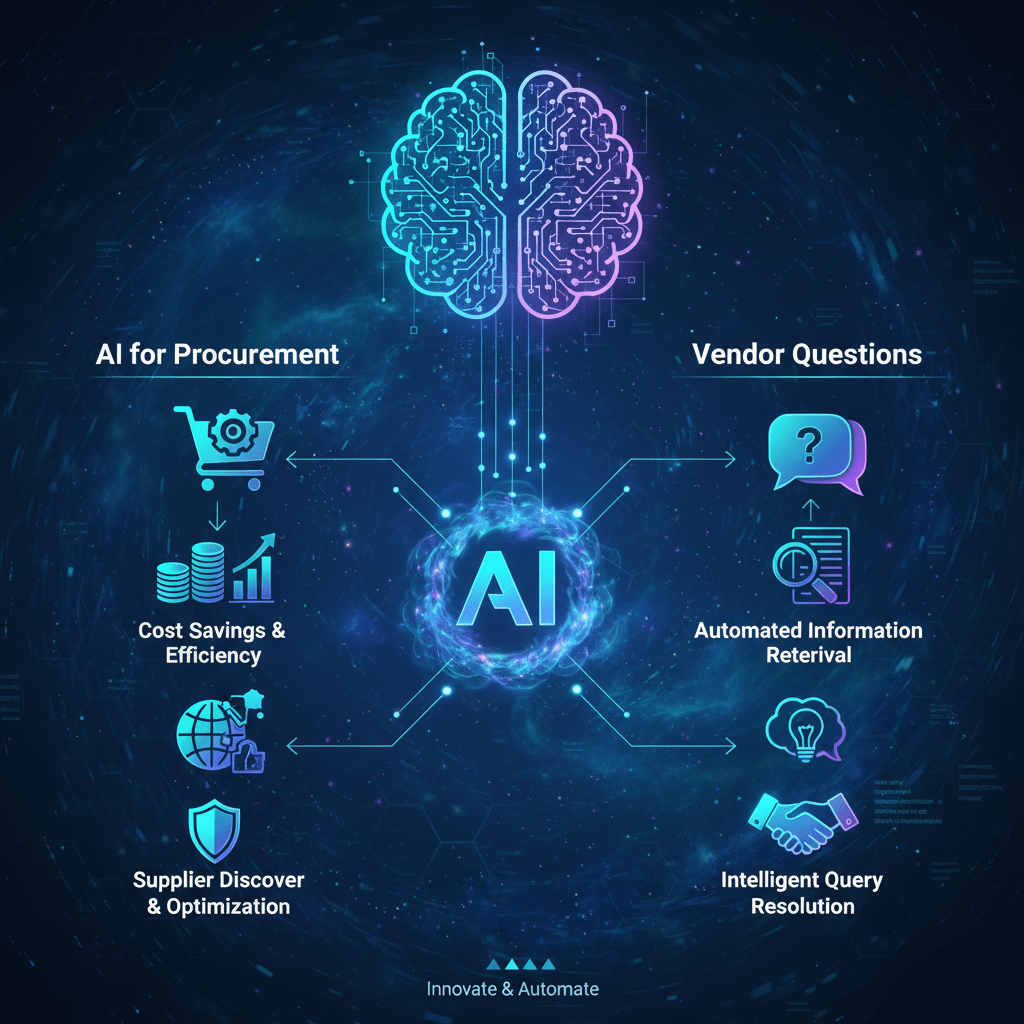“Implement AI for procurement and vendor questions to eliminate maverick spending, ensure policy compliance, and free your team from internal helpdesk work, allowing them to focus on strategic value.”
Picture this. It’s 9:05 AM on a Tuesday. You’re a procurement manager, finally carving out time to analyze a critical supplier contract renewal. This negotiation could save the company six figures this year.
Your focus is sharp. Then, the pings begin.
- Ping (Slack): “Who is our approved vendor for office supplies?”
- Ping (Email): “FW: Urgent – What is the spending limit for software?”
- Ping (Teams): “Hey, where can I find the travel expense policy again?”
- Ping (Email): “Do I need a PO for a $300 online course?”
- Ping (Slack): “What’s the status of invoice #45A-882?”
By 10:30 AM, you haven’t even opened the supplier contract. You’ve spent your entire morning as an internal helpdesk, answering the same questions you answered last week. Your strategic work is still waiting.
This isn’t a hypothetical. This is the daily reality for procurement and finance departments everywhere. You are the custodians of the company’s spending policies and vendor relationships, but this role has turned you into a human search engine.
The problem is clear. Your colleagues want to do the right thing. They want to follow the rules. However, they are unaware of the rules or where to find them. The cost of this friction is staggering. It leads to lost productivity (for you and them), employee frustration, and its most expensive symptom: maverick spending.
What if there was a way to stop this? What if you could give every employee a 24/7 expert assistant that knows every single one of your policies and vendors, inside and out?
There is. It’s an AI agent, and it’s about to become procurement’s new best friend.

The Hidden Cost of “Just Answering Questions”
We often dismiss these interruptions as “just part of the job.” But let’s actually calculate the cost.
Let’s say your procurement team of five people spends, conservatively, 20% of their day (about 1.5 hours) just answering these basic, repetitive questions.
- 5 people x 1.5 hours/day = 7.5 hours per day.
- 7.5 hours/day x 5 days/week = 37.5 hours per week.
- That is the entire salary of one full-time employee dedicated to answering manual FAQs.
Now, multiply that by the cost to the rest of the company. Every employee who sends you a question is also stopped, waiting for your reply. They can’t book their travel. They can’t order their supplies. They can’t hire their freelancer. The entire business slows down, one “quick question” at a time.
This constant Q&A clog creates three massive, costly problems.
1. It Kills Procurement’s Strategic Value
Every minute your team spends looking up a policy link is a minute they aren’t doing:
- Strategic Sourcing: Finding better vendors and new savings opportunities.
- Supplier Relationship Management: Building partnerships and mitigating risks.
- Contract Negotiation: Fighting for better terms and pricing.
- Process Improvement: Actually fixing the source-to-pay (S2P) process.
Your team is stuck in reactive, low-value work, completely blocking them from the proactive, high-value work you hired them for. This also crushes morale. Nobody gets a finance degree because they love copying and pasting links from a wiki.
2. It Fuels Maverick Spending
What happens when an employee can’t find the answer quickly? They don’t wait.
A marketing manager needs a graphic designer for an “urgent” project. They are unfamiliar with the supplier onboarding process. They are unaware of the approved vendors. So, what do they do?
They go to Google. They find a random freelancer. They pay with their corporate card.
Boom. You have maverick spending.
This creates a cascade of disasters. The vendor has not been vetted for security or compliance. There’s no contract in place. The price is likely higher than your negotiated rates. And now, AP has to deal with a rogue invoice for an unknown vendor, which costs them even more time and resources. This happens because finding the right way was just too hard.
3. It Creates a Terrible Internal Experience
Your colleagues in sales, marketing, and engineering are your internal customers. Currently, their customer experience is subpar. They see procurement as a black box. A gatekeeper. A source of “No.”
They have to send an email into the void and hope for a quick reply. When they do get an answer, it might be a link to a 40-page, legalese-filled corporate purchasing policy PDF. This is deeply frustrating for them and damages your department’s reputation.
The Old Guard: Why Your Intranet and ERP Aren’t Enough
“But wait,” you say. “We have tools for this! We have an intranet. We have an ERP!”
Let’s be honest. Do they really work?
The Document Graveyard (Your Intranet/Wiki)
Your intranet (maybe it’s SharePoint, Confluence, or an internal Google Site) is where documents go to die.
You painstakingly wrote a beautiful purchasing guide and an approved vendor list. You uploaded them. And… nobody can find them.
An employee searches for “laptop policy.” The intranet search bar returns:
- A 3-year-old blog post about the company picnic.
- 12 different versions of the “T&E Policy,” all with different dates.
- A link to the IT helpdesk.
- …and no clear answer.
These tools are static repositories. They are data-dumb. They can’t synthesize information. They can’t understand user intent. A user doesn’t want a 40-page document; they want a single answer: “How much can I spend on a new monitor?” Your intranet can’t provide that.
The Expert’s Fortress (Your ERP System)
Your ERP integration (with tools like SAP, Oracle, or NetSuite) is the backbone of your operations. It is your system of record. It is powerful, precise, and… completely unusable for 95% of your employees.
These systems are built for procurement and finance experts. They are not “walk-up-and-use” friendly.
A sales director will never, ever log into your ERP to “look up the preferred vendor code for travel.” It’s not going to happen. They lack the training, time, or patience. While the ERP holds the data (like the vendor management system list), it’s locked away in a fortress.
So, the old tools fail. The intranet is a graveyard. The ERP is a fortress.
Employees are left with no choice but to ping you directly. You are the only “search engine” that works.
A New Front Door: The Intelligent AI Agent
Imagine a new “front door” for procurement.
It sits right where your employees already work—inside Slack, Microsoft Teams, or as a simple chat window on your intranet.
An employee can ask anything. In plain, everyday language.
- Employee: “I need a new software subscription for my team, it’s about $2,000/year. What do I do?”
- AI Agent: “Great. According to our Corporate Purchasing Policy (Sec. 3.a), all software subscriptions over $500 require a purchase order. Our approved vendor for SaaS management is ‘Vendr’. If this is a new piece of software, you’ll first need to complete the ‘New Vendor Intake Form’ to begin the supplier onboarding process. Here is the link to the form.”
This is not a generic chatbot. This is a specialized AI agent that you have trained on your specific, private documents.
You feed it:
- Your approved vendor lists (in Excel, CSV, or PDF format).
- Your complete Corporate Purchasing Policy (Word, PDF).
- Your Travel & Expense Policy.
- Your ‘How-to’ guides for creating a PO.
- Your ‘How-to’ guides for submitting an invoice.
- Your IT security checklists for new software.
The AI agent reads and understands all of it. It doesn’t just “search” for keywords. It synthesizes the information from multiple documents to provide a single, complete, and actionable answer.
It becomes your 24/7 procurement expert. It’s an internal helpdesk that never sleeps, never gets frustrated, and always gives a 100% compliant answer.
The Ripple Effect: Benefits Across the Entire Source-to-Pay Lifecycle
This is where the transformation gets truly exciting. An AI agent does more than just answer questions. It actively improves every single step of your procurement process.
1. The Ultimate Weapon to Reduce Maverick Spending
This is the big one. Maverick spending, as we know, happens because the “right way” is too hard.
The AI agent flips this script. It makes compliance the path of least resistance.
It is faster for an employee to ask the AI agent, “Where can I buy a standing desk?” than it is for them to open Amazon.
- Employee: “I need a standing desk.”
- AI Agent: “Our approved vendor for all office furniture is ‘Office Solutions Inc.’ You can access their pre-negotiated catalog here: [link]. All purchases under $1,000 are pre-approved for your department. Please use your corporate card and submit the receipt in ‘Emburse’.”
Result: The employee gets what they need in seconds. The company receives its negotiated discount. The purchase is accurately tracked and categorized. Compliance is achieved, not by force, but by convenience.
2. Finally, Real Procurement Process Automation
We hear “automation” and think of complex, million-dollar software projects. But the most powerful automation is often the simplest.
This AI agent automates the 37.5 hours per week your team was wasting on Q&A. This isn’t just a small win; it’s a fundamental change in your team’s entire function.
This frees up your human experts for procurement process automation that genuinely matters. Instead of answering “What’s the policy?” your team can now focus on:
- Automating PO creation for recurring utility bills.
- Setting up e-invoicing with your top 20 suppliers.
- Analyzing spend data (which is now cleaner!) to find new consolidation opportunities.
You automate the noise so you can focus on the music.
3. A Smarter, Cleaner Purchase Order Process
Bad purchase order process management is a plague for both procurement and AP. POs come in with the wrong vendor code, no budget code, or for items that violate policy.
The AI agent acts as a “pre-check” before the PO is even created.
- Employee: “I need to make a PO for a $10,000 consulting service.”
- AI Agent: “Understood. For professional services over $5,000, you must have a signed Statement of Work (SOW) before creating a PO. Also, please confirm this vendor has completed our supplier onboarding and is active in our vendor management system. Once you have the SOW, you can create the PO in our ERP system at this link [link], using GL code 5012 (‘Consulting Services’).”
This simple interaction prevents a bad PO from ever entering the system. The PO that does arrive is clean, compliant, and ready for approval. This means faster approvals for the employee and less manual rework for your team.
4. Streamlining Supplier Onboarding and Your Vendor Management System
Your vendor management system (VMS) is your single source of truth for suppliers. However, integrating a new supplier into that system is often a chaotic, email-driven process.
The AI agent centralizes and guides this critical process.
- Employee: “My manager told me to hire a new marketing agency. What’s the process?”
- AI Agent: “I can help with that. Our supplier onboarding process has four steps:
- The internal sponsor (you) completes the ‘New Vendor Business Justification’ form.
- The vendor completes our ‘Security & Compliance Questionnaire’ and provides a W-9 and banking details.
- Procurement and Legal review and sign the Master Service Agreement (MSA).
- The vendor is created in the VMS, and a vendor ID is issued.
You must complete step 1 before any work begins. Here is the link to the form.”
The agent acts as the gatekeeper, ensuring no vendor starts work without being properly vetted. This protects the company from risk and ensures your VMS data stays accurate from day one.
5. A 24/7 Internal Helpdesk That Actually Helps
Let’s face it. Procurement has become an unwilling internal helpdesk. This AI agent makes it official, but in a way that scales.
It is the single, centralized, “go-to” resource for every spending question in the company.
- It’s available 24/7 for your global teams in different time zones.
- It provides consistent answers. No more “Well, Sarah told me this, but Tom told me that.”
- It’s infinitely patient. It will happily answer “Where is the T&E policy?” 500 times a day.
This dramatically improves the perception of your department. You are no longer the “Department of No.” You are the “Department of Instant Answers.” You become an enabler, not a blocker.
6. Supporting Your Accounts Payable Automation Journey
The pain doesn’t stop at procurement. Your colleagues in Accounts Payable are also drowning in questions. “Where’s my invoice?” “What’s the status of my payment?” “Why was my invoice rejected?”
A simple AI for procurement and vendor questions can be a game-changer for AP, too. By feeding the agent basic “how-to” guides, you can deflect a massive volume of queries.
- Vendor (via a public-facing portal): “What is the status of invoice #99021?”
- AI Agent: “Invoice #99021 was received on Oct 24th. It was matched to PO #1209 and is approved. Per your 30-day terms, payment is scheduled for Nov 23rd.”
- Employee: “My invoice got rejected. Why?”
- AI Agent: “Invoices are commonly rejected for two reasons: 1) The PO number is missing or incorrect, or 2) The quantity/price on the invoice does not match the PO. Please check these two items and resubmit to [email protected].”
This is a critical part of accounts payable automation. It clears the decks for the AP team to focus on high-stakes exception handling, not basic status updates.
7. The Power-Up: Smart ERP Integration
This is the final, most powerful step. On its own, the AI agent is a knower—it knows all your static policies and documents.
But with ERP integration, it becomes a doer.
When connected to your ERP, the agent can fetch live, dynamic data.
- Employee: “Do we have an active PO for ‘Creative Solutions’?”
- AI Agent (after checking the ERP): “Yes, PO #1210 is active with ‘Creative Solutions’ for $15,000, with $4,500 remaining.”
- Employee: “What’s the remaining budget for my department’s ‘Software’ cost center?”
- AI Agent (after checking the ERP): “Your department (Marketing – #410) has $22,500 remaining in its ‘Software’ budget (GL 5015) for Q4.”
This connects your user-friendly “front door” (the AI agent) directly to your powerful “system of record” (the ERP). It bridges the gap. It provides a human-centric way for anyone to get data from your most complex system, securely and instantly. This is the future of the entire source-to-pay (S2P) ecosystem.
How to Build Your Procurement AI Agent (It’s Much Easier Than You Think)
You might be reading this and thinking, “This sounds amazing. But I’m in procurement, not IT. This must require a team of data scientists and a six-month project.”
Five years ago, you’d be right. Today, you are wrong.
With the rise of no-code AI platforms, you—the procurement manager, the AP lead, the finance director—can build this yourself in an afternoon.
Here is the simple, five-step plan.
- Step 1: Gather Your Knowledge. This is the only “hard” part, and you already have all of it. Go into your folders, email, and intranet, and find the “single source of truth” documents.
- Approved Vendor List
- Corporate Purchasing Policy
- T&E Policy
- P-Card Policy
- Supplier Onboarding Guide
- How-to-Create-a-PO Walkthrough
- A simple text file or Excel sheet of the top 20 questions you get every day.
- Step 2: Choose a No-Code AI Builder. You need a tool designed for this exact purpose. A platform that lets you “bring your own data” and build a secure, private AI agent.
- Step 3: Upload and “Train”. This is the magic. You literally drag and drop your documents into the platform. You hit “Create Agent.” The AI reads, analyzes, and learns everything. There is no “coding.” You are not writing rules. You are just giving it the rulebook.
- Step 4: Test and Refine. You immediately start asking it questions.
- “What’s the limit for team meals?”
- “Who is our vendor for legal services?”
- “Do I need a PO for $100?”
See how it answers. If it gets something wrong, it’s not the AI’s fault; it’s likely your document is unclear. This process instantly reveals the gaps in your own policies. You can then update the document and re-upload it, making the agent (and your policies) smarter.
- Step 5: Deploy. Once you’re satisfied, the platform provides a straightforward way to share your agent. You can embed it on your intranet page, share a link, or plug it into Slack or Teams. Instantly, your new 24/7 assistant is live and working for the entire company.
The Solution: Build Your Procurement Assistant in Minutes with Scalewise.ai
All of this theory is great, but you need a tool to put it into practice. The perfect tool for this job is Scalewise.ai.
Scalewise.ai is a free, no-code AI agent builder explicitly designed for this purpose. It’s designed for business experts (like you) to build powerful AI assistants without writing a single line of code.
Here is why it’s the right choice for your procurement department:
- It’s Truly No-Code: If you can make a PowerPoint presentation, you can build an agent in Scalewise.ai. You upload your documents (PDFs, Word, Excel, and .txt files), and it just works.
- It’s Free to Start: You can build and test your complete procurement agent right now, for free. This isn’t a long, expensive enterprise sale. It’s a tool you can use today to solve your problem.
- It’s Secure and Private: This is critical. Your vendor lists and policies are sensitive. Scalewise.ai is secure. Your data is your data. It is used only to answer your employees’ questions and is not used to train any other models.
- It’s Built to Integrate: While you can start with just documents, Scalewise.ai is designed to connect seamlessly with other systems. This means that your “Phase 2” plan of connecting to your ERP or VMS is not only possible, but also straightforward.
You can stop the email deluge this week.
Go to Scalewise.ai. Sign up for a free account. Create a new agent called “Procurement Pro.” Upload your top 5 policy PDFs and your main vendor list.
Then, deploy it to your team. The relief will be immediate. You will finally get your day back.
Conclusion: Stop Answering, Start Strategizing
The flood of repetitive questions your team faces isn’t a personal failing; it’s a common challenge that many teams face. It’s a system failure. It’s a sign that your valuable knowledge is locked in formats and tools that don’t work for the modern employee.
You cannot solve this problem by answering emails faster. You can only solve it by providing a better, more efficient system.
An AI for procurement and vendor questions is that system. It’s a 24/7, self-service portal that provides instant, compliant, and accurate answers to every employee.
This simple, powerful tool:
- Stops maverick spending before it starts.
- Ensures policy compliance by making it effortless.
- Streamlines your purchase order and supplier onboarding processes.
- Frees your team from low-value Q&A to focus on high-value strategic work.
Stop being a human search engine. Start being a strategic partner to the business.
Build your free procurement AI agent on Scalewise.ai and reclaim your time.
Frequently Asked Questions (FAQs)
Q: Will an AI agent like this replace procurement jobs?
A: No. It saves procurement jobs from being mind-numbingly administrative. This agent handles the $10/hour work (answering basic Q&A) so your professional team can focus on the $100/hour work (negotiation, risk analysis, strategic sourcing). It’s a force multiplier that makes your human team more valuable, not less.
Q: How secure is our sensitive data, like vendor pricing?
A: This is a crucial question. Platforms like Scalewise.ai are built with enterprise-grade security. Your data is encrypted, kept private, and used solely to power your agent. You control who has access. Unlike public AI tools, your private data is never leaked or used to train public models.
Q: What if the AI gives the wrong answer?
A: The AI agent is only as good as the data you give it. If the agent provides a wrong answer, it’s almost always because the source document is outdated, unclear, or contradictory. This is actually a benefit. The AI acts as a mirror, showing you exactly where your documentation is weak. You fix the source document (e.g., delete the old policy), re-upload it, and the AI is instantly corrected.
Q: How is this different from a generic chatbot, like the one on an airline website?
A: Those generic bots are “rule-based” or trained on broad, public knowledge. A procurement AI agent is a “Generative AI” agent trained exclusively on your private, specific knowledge base. It doesn’t know “the best restaurant in New York.” It is familiar with your T&E policy for New York, your approved vendor list, and your PO process. It’s a specialist, not a generalist.
Q: How long does this really take to set up?
A: We are not exaggerating when we say “minutes.” You can have a “Version 1” of your agent running in less than 15 minutes. Just gather your top 5 policy PDFs and your main vendor list, sign up for a free Scalewise.ai account, and upload them. You can test your new agent before your next coffee break.
Q: Can this really integrate with our complex, old ERP system?
A: Yes. Modern platforms like Scalewise.ai are built with “connectors” or “APIs” designed to talk to other systems. While you will likely start with just documents (which provide 80% of the value), the platform is ready when you are to connect to your ERP, VMS, or AP system to pull in that live, dynamic data.





